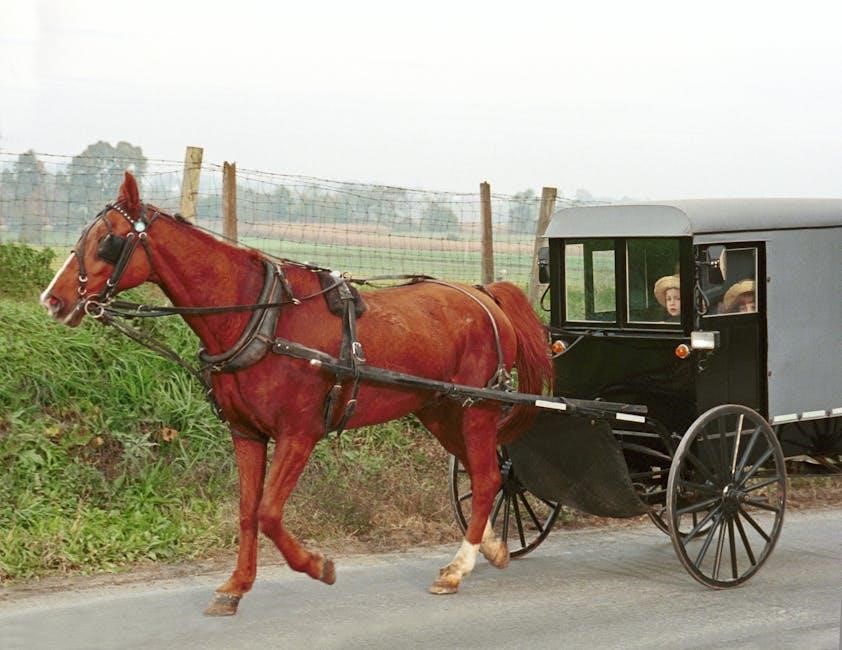This guide provides essential insights into equine joint injection techniques and medications. Consulting a veterinarian is crucial to determine the best treatment for your horse’s joint health. Aseptic techniques minimize complications.
Equine joint injections are a common therapeutic approach to managing joint-related issues in horses, particularly for maintaining soundness and addressing inflammation. These injections deliver medication directly into the joint, targeting the source of pain or inflammation. They are often used to treat conditions like arthritis, synovitis, or degenerative joint diseases. Veterinary consultation is essential to determine the appropriate treatment and ensure safety. Aseptic techniques are critical to minimize the risk of complications, such as septic arthritis. Joint injections can significantly improve a horse’s comfort and performance, making them a valuable tool in equine care. Proper preparation and aftercare are vital to maximize the benefits and prevent adverse effects. By understanding the procedures and risks, horse owners can make informed decisions about their horse’s health.
Why Joint Injections Are Important for Horse Health
Joint injections are a vital component of equine health care, particularly for horses experiencing pain or inflammation in their joints. These injections deliver targeted medication to address conditions such as arthritis, synovitis, or degenerative joint diseases. By reducing inflammation and pain, joint injections can significantly improve a horse’s quality of life and performance. They are especially beneficial for equine athletes, where joint health is critical for mobility and functionality. Regular injections can prevent further joint deterioration and enhance the horse’s ability to move comfortably. Additionally, they play a key role in maintaining soundness, which is essential for horses engaged in rigorous physical activities. Early intervention with joint injections can prevent more severe joint issues from developing. Thus, they are a valuable tool in preserving the long-term health and well-being of horses.

Types of Joint Injections
Equine joint injections include corticosteroids, hyaluronic acid, and IRAP therapy. These treatments target inflammation and joint health, improving mobility and reducing pain in horses. Each type addresses specific joint conditions effectively.
Corticosteroid Injections
Corticosteroid injections are a common treatment for equine joint conditions, reducing inflammation and pain. They are often used to manage osteoarthritis and other degenerative joint diseases in horses. These injections deliver anti-inflammatory medications directly into the joint, providing rapid relief. However, their use must be carefully balanced to avoid potential side effects, such as cartilage degradation. Veterinarians typically recommend corticosteroid injections for short-term pain management or to improve joint function in cases of acute inflammation. Proper aseptic techniques are essential to minimize the risk of complications, such as septic arthritis. While effective, corticosteroid injections should not be overused, as they may weaken joint structures over time. Always consult a veterinarian to determine if this treatment is appropriate for your horse’s specific condition.
Hyaluronic Acid Injections
Hyaluronic acid injections are widely used in equine joint therapy to improve joint lubrication and reduce inflammation; This natural substance mimics the viscosity of normal joint fluid, providing cushioning and shock absorption. It is particularly effective in treating conditions like osteoarthritis, where joint fluid becomes less viscous. Hyaluronic acid injections can be administered directly into the joint or intravenously, depending on the severity of the condition. They are often combined with other medications for enhanced therapeutic effects. While they do not reverse joint damage, they can significantly improve joint function and reduce pain. Regular use of hyaluronic acid injections may help maintain joint health in performance horses. However, their efficacy varies among individuals, and veterinarians recommend them based on the horse’s specific needs and diagnosis.
IRAP (Interleukin-1 Receptor Antagonist Protein) Injections
IRAP therapy is a cutting-edge, biological treatment for equine joint conditions, utilizing the horse’s own blood to produce anti-inflammatory medication. It targets interleukin-1, a key inflammatory cytokine, to reduce joint inflammation and promote healing. This therapy is particularly effective for treating osteoarthritis and other degenerative joint diseases. The process involves extracting blood from the horse, processing it to concentrate the IRAP protein, and re-injecting it into the affected joints. Unlike corticosteroids, IRAP injections are derived naturally from the horse’s body, minimizing side effects. They are often recommended for horses with chronic joint issues or those that do not respond well to traditional treatments. IRAP injections can improve joint function, reduce pain, and enhance the horse’s overall quality of life. Regular veterinary monitoring is essential to assess treatment progress and ensure optimal results.
Preparation for Joint Injections
Proper preparation is vital for safe and effective joint injections. Choosing the right medication and ensuring aseptic conditions minimize complications, while assessing the horse’s health ensures optimal treatment outcomes.
Choosing the Right Medication
Selecting the appropriate medication for joint injections is critical to ensuring effectiveness and minimizing risks. Corticosteroids, hyaluronic acid, and IRAP are common options, each serving different purposes. Corticosteroids reduce inflammation, while hyaluronic acid lubricates joints, and IRAP targets specific inflammatory pathways. The choice depends on the horse’s diagnosis, severity of joint issues, and long-term goals. Consulting with a veterinarian ensures the medication aligns with the horse’s specific needs. Generic approaches may not yield optimal results, as joint conditions vary widely. Proper dosing and frequency are also essential to avoid overuse, which can lead to adverse effects. Vets may recommend combining medications for enhanced benefits, but this requires careful consideration of potential interactions. Ultimately, personalized treatment plans are key to improving joint health and maintaining the horse’s athletic performance.
Aseptic Techniques to Minimize Complications
Aseptic techniques are crucial when performing equine joint injections to prevent complications like septic arthritis. Proper sterilization of the injection site and equipment is essential to minimize infection risks. Veterinarians use sterile needles, syringes, and antiseptic solutions to prepare the area. The horse should be restrained appropriately to avoid movement during the procedure. A clean and quiet environment reduces contamination chances and stress on the horse. Strict adherence to these protocols ensures the safety and effectiveness of the treatment. Improper techniques can lead to severe joint infections, which may require prolonged recovery or even surgery. Regular training and updates for veterinarians on the latest aseptic methods are vital to maintaining high standards of care. By prioritizing cleanliness and precision, the risk of complications is significantly reduced, promoting better outcomes for the horse.

Joint Injection Techniques
Joint injection techniques involve precise methods to deliver medication directly into the joint. US-guided Navicular Bursa Injections ensure accuracy, reducing risks and improving treatment effectiveness in performance horses. These techniques require advanced veterinary expertise.
US-Guided Navicular Bursa Injections
US-guided Navicular Bursa Injections are a minimally invasive technique used to treat navicular syndrome in horses. Ultrasound guidance ensures precise medication delivery into the navicular bursa, reducing complications and improving accuracy. This method is particularly effective for targeting inflammation and pain in the navicular region, a common issue in performance horses. Veterinarians use real-time imaging to locate the bursa accurately, minimizing the risk of injection errors. Research highlights that this approach significantly reduces the risk of septic arthritis when proper aseptic techniques are applied. The procedure is often performed under sedation, allowing the horse to remain comfortable throughout. US-guided injections are a valuable tool in maintaining equine athletes’ soundness and longevity. Regular consultation with a veterinarian is essential to determine if this treatment is suitable for your horse’s specific condition.
Facet Joint Injections
Facet joint injections are a specialized treatment for horses experiencing pain and inflammation in the cervical or lumbar spine. These injections typically involve corticosteroids to reduce swelling and alleviate discomfort in the facet joints. The procedure is often performed under ultrasound guidance to ensure accurate needle placement. Facet joint injections are particularly beneficial for horses with chronic back pain or arthritis, as they target the source of inflammation directly. Veterinarians emphasize the importance of aseptic techniques to minimize the risk of complications, such as infection. While effective, facet joint injections are usually part of a broader treatment plan that may include physical therapy or changes in the horse’s exercise regimen. Consulting with a veterinarian is essential to determine if this therapy is appropriate for your horse’s condition and to discuss potential risks and benefits.
Lumbosacral and Sacroiliac Injection Techniques
Lumbosacral and sacroiliac injections target the joints in the lower back, crucial for a horse’s mobility and comfort. These injections are often used to address pain and inflammation in the lumbosacral and sacroiliac regions. Ultrasound guidance is commonly employed to ensure precise needle placement, minimizing the risk of complications. Corticosteroids are frequently administered to reduce swelling and relieve discomfort. Aseptic techniques are essential to prevent infection and ensure the procedure’s safety. Equine athletes with chronic back pain or arthritis often benefit from this treatment. Veterinarians may recommend these injections as part of a comprehensive care plan, which could include physical therapy or adjustments to the horse’s exercise routine. Proper technique and sterile conditions are critical to achieving optimal results and safeguarding the horse’s well-being.
Safety and Risks

Ensuring safety involves minimizing infection risks through sterile techniques and proper dosing. Aseptic protocols are critical to prevent complications like septic arthritis. Careful administration is vital for effective treatment.
Minimizing the Risk of Septic Arthritis
Septic arthritis is a serious complication of joint injections, requiring meticulous attention to aseptic techniques. Veterinarians must use sterile equipment and ensure the injection site is thoroughly cleaned to reduce bacterial contamination. Proper handling of medications and avoiding multiple injections in the same joint can further minimize risks. Monitoring for signs of infection, such as swelling or heat, is essential post-injection. If suspected, prompt veterinary intervention is critical to prevent long-term joint damage. Adherence to strict hygiene protocols and using high-quality, sterile medications are cornerstone practices to safeguard equine health during joint injection therapies.
Possible Complications and How to Avoid Them
While joint injections are generally safe, potential complications include tendon rupture, lameness, and allergic reactions. To minimize these risks, proper injection technique and medication selection are critical. Ensuring the horse is properly sedated and restrained can prevent sudden movements during the procedure. Using ultra-sound guidance for precise placement reduces the chance of hitting sensitive structures; Monitoring for signs of adverse reactions, such as swelling or pain, is essential post-injection. Avoiding overuse of corticosteroids can prevent cartilage degradation. Consulting with a veterinarian to tailor treatment to the horse’s specific condition further reduces complications; Regular follow-ups ensure any issues are addressed promptly, promoting optimal recovery and joint health.

Monitoring and Aftercare
Post-injection, monitor your horse for signs of complications like swelling or pain. Follow your veterinarian’s advice to ensure proper recovery and prevent adverse reactions. Avoid rushing back to exercise.
Post-Injection Care for Your Horse
Proper post-injection care is vital to ensure your horse’s recovery and minimize complications. Monitor your horse closely for any signs of swelling, pain, or lameness after the procedure. Your veterinarian may recommend a period of rest or reduced exercise to allow the medication to take effect. Keeping the injection site clean and dry is essential to prevent infection. Additionally, avoid administering any other medications without consulting your vet, as this could interfere with the treatment. Follow your veterinarian’s specific instructions regarding exercise and care routines to promote healing and maximize the effectiveness of the joint injection. Regular follow-ups with your vet will help assess the treatment’s success and address any potential issues early on.
When to Resume Exercise After Joint Injections
Resuming exercise after joint injections requires careful consideration to ensure optimal recovery. Your veterinarian will typically recommend a 3- to 7-day rest period to allow the medication to take effect and reduce the risk of complications. During this time, your horse should avoid strenuous activities, such as jumping or high-impact work. Once cleared by your vet, gradually reintroduce light exercise, such as walking or trotting, to prevent overwhelming the joints. Monitoring your horse’s comfort and mobility is crucial, as overt exertion too soon can negate the benefits of the injection. Always follow your veterinarian’s guidance, as the specific timeline may vary depending on the type of injection and your horse’s condition. Proper adherence to post-injection protocols ensures a safer and more effective return to activity.
Role of the Veterinarian
Veterinarians play a crucial role in diagnosing joint issues and developing personalized treatment plans. They ensure the safety and efficacy of joint injections, minimizing risks and complications through proper techniques and monitoring.
Consulting Your Veterinarian Before Treatment
Consulting your veterinarian before treatment is crucial for your horse’s health. They will assess your horse’s condition, diagnose joint issues, and recommend appropriate treatment options. A thorough evaluation ensures that joint injections are the best course of action.
Veterinarians can identify underlying causes of joint pain and determine if injections are suitable. They also consider the horse’s age, health status, and athletic demands to create a personalized treatment plan.
Discussing risks, such as septic arthritis, and benefits with your vet is essential. Proper aseptic techniques and medication selection minimize complications, ensuring the procedure is safe and effective.
Your vet will guide you on post-injection care and exercise resumption. Open communication ensures your horse receives the best possible outcome and maintains optimal joint health.
Discussing Joint Injection Therapy with Your Vet
Discussing joint injection therapy with your veterinarian is vital to ensure the treatment aligns with your horse’s specific needs. Your vet will explain the procedure’s risks and benefits, helping you make informed decisions. They will also outline the expected outcomes and recovery process.
Open dialogue allows you to ask questions about the types of injections, such as corticosteroids or hyaluronic acid, and their suitability for your horse. Your vet can provide guidance on the best approach based on the diagnosis and severity of joint issues.
Use this opportunity to discuss concerns about potential complications, like septic arthritis, and how to minimize them. Your vet will also advise on post-injection care and when to resume exercise safely.
This collaboration ensures your horse receives the most effective and safe treatment, tailored to their condition and your goals.
Final Thoughts on Equine Joint Injections
Equine joint injections are a critical tool in maintaining horses’ joint health and performance. By consulting a veterinarian, owners can ensure safe and effective treatment. Aseptic techniques are essential to minimize risks like septic arthritis. While joint injections are beneficial, it’s important to follow evidence-based guidelines, even though they may be limited. Discussing treatment options with a vet helps tailor therapy to the horse’s specific needs. Proper post-injection care and gradual return to exercise are key for optimal recovery. Joint injections, when administered correctly, can significantly improve a horse’s soundness and quality of life. Always prioritize professional advice to make informed decisions for your horse’s well-being.


